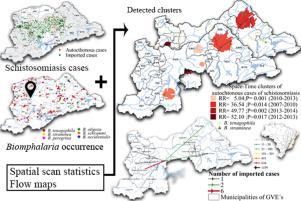Acta Tropica ( IF 2.1 ) Pub Date : 2021-09-10 , DOI: 10.1016/j.actatropica.2021.106132 Raquel Gardini Sanches Palasio 1 , Thays de Jesus Rossignoli 2 , Riccardo Costabile Simone Di Sessa 2 , Fernanda Pires Ohlweiler 2 , Francisco Chiaravalloti-Neto 1

|
The present study identified locations with the presence of Biomphalaria and the areas at risk for Schistosoma mansoni, the etiological agent of schistosomiasis, in the Metropolitan Region of São Paulo (MRSP), located in the Alto Tietê Basin (ATB), São Paulo, Brazil. The study area comprises floodplains of the Tietê River from its source, in Salesópolis, to Rasgão Dam, in Pirapora do Bom Jesus, covering 39 municipalities. Data from the planorbidic chart of the malacology laboratory of the Endemic Control Superintendence for 2008–2016 were used, as well as data from the notification forms of cases of human schistosomiasis in 2006–2015 made available by the Epidemiological Surveillance Groups of Mogi das Cruzes and Osasco, and by the Health and Surveillance Coordination of São Paulo. These data were used to generate maps of the distribution of Biomphalaria, of the scanning analysis, of the Gi statistics of the autochthonous and imported schistosomiasis cases, and of the flow of cases imported from other Brazilian states and municipalities in the state of São Paulo to the study area. A total of 21,618 specimens of the genus Biomphalaria were captured and six species were identified. Biomphalaria tenagophila was the predominant species in the region and of greatest epidemiological importance as it is the main responsible for the transmission of the disease in the state of São Paulo. A total of 3,623 cases of schistosomiasis were reported in the study area, and São Paulo and Guarulhos were the municipalities with the highest number of autochthonous and imported cases during the study period. The imported cases originated from 21 Brazilian states plus the Federal District and from 51 municipalities in São Paulo state located outside the study area. Autochthonous clusters with high risk for the occurrence of schistosomiasis were identified in the municipalities of São Paulo, Guarulhos, Santa Isabel/Mogi das Cruzes/Arujá, and Cotia/Itapevi. Clusters of imported cases were also identified in Itaquaquecetuba, at the border of Cotia/Itapevi and Suzano/São Paulo/Mogi das Cruzes. The presence of B. tenagophila in the ATB and in the clusters of autochthonous cases herein identified, although not carrying schistosome larvae, represents a risk for the transmission of infectious agents. The human population in the MRSP mainly occupies the lowlands of the Tietê River, which are locations with poor coverage of basic sanitation. Therefore, measures for the control and surveillance of schistosomiasis such as educational actions, improvements in basic sanitation, and the malacological and epidemiological monitoring of these areas are extremely important.
中文翻译:

巴西圣保罗 Alto Tietê 盆地血吸虫病高危地区的空间分析
本研究在位于巴西圣保罗的上铁特盆地 (ATB) 的圣保罗大都会区 (MRSP) 中确定了存在疟原虫的位置和存在血吸虫病病原体曼氏血吸虫的风险区域. 研究区域包括 Tietê 河的泛滥平原,从它的源头,Salesópolis,到 Rasgão 大坝,Pirapora do Bom Jesus,覆盖 39 个城市。使用了 2008-2016 年地方病控制监管局软糖学实验室平面病图的数据,以及 Mogi das Cruzes 和Osasco 和圣保罗的健康与监测协调局。这些数据用于生成生物疟原虫分布图、扫描分析图、本土和输入血吸虫病病例的 Gi 统计数据以及从巴西其他州和圣保罗州直辖市输入的病例流向研究区。共捕获了 21,618 份Biomphalaria标本,并确定了 6 个物种。铁线莲是该地区的主要物种,具有最大的流行病学重要性,因为它是圣保罗州疾病传播的主要原因。研究区共报告血吸虫病 3,623 例,圣保罗和瓜鲁柳斯是研究期间本土和输入病例数最多的直辖市。输入病例来自巴西的 21 个州和联邦区以及位于研究区域外的圣保罗州的 51 个市。在圣保罗市、瓜鲁柳斯市、圣伊莎贝尔/莫吉达斯克鲁兹/阿鲁哈市和科蒂亚/伊塔佩维市发现了发生血吸虫病的高风险本土集群。在 Itaquaquecetuba 也发现了一批输入性病例,在 Cotia/Itapevi 和 Suzano/São Paulo/Mogi das Cruzes 的边界。的存在B. tenagophila在 ATB 和本文确定的本地病例群中,虽然不携带血吸虫幼虫,但代表了传染性病原体传播的风险。MRSP 中的人口主要居住在铁特河低地,这些地方是基本卫生设施覆盖率较低的地区。因此,控制和监测血吸虫病的措施,如教育行动、改善基本卫生条件以及对这些地区的病原学和流行病学监测极为重要。











































 京公网安备 11010802027423号
京公网安备 11010802027423号